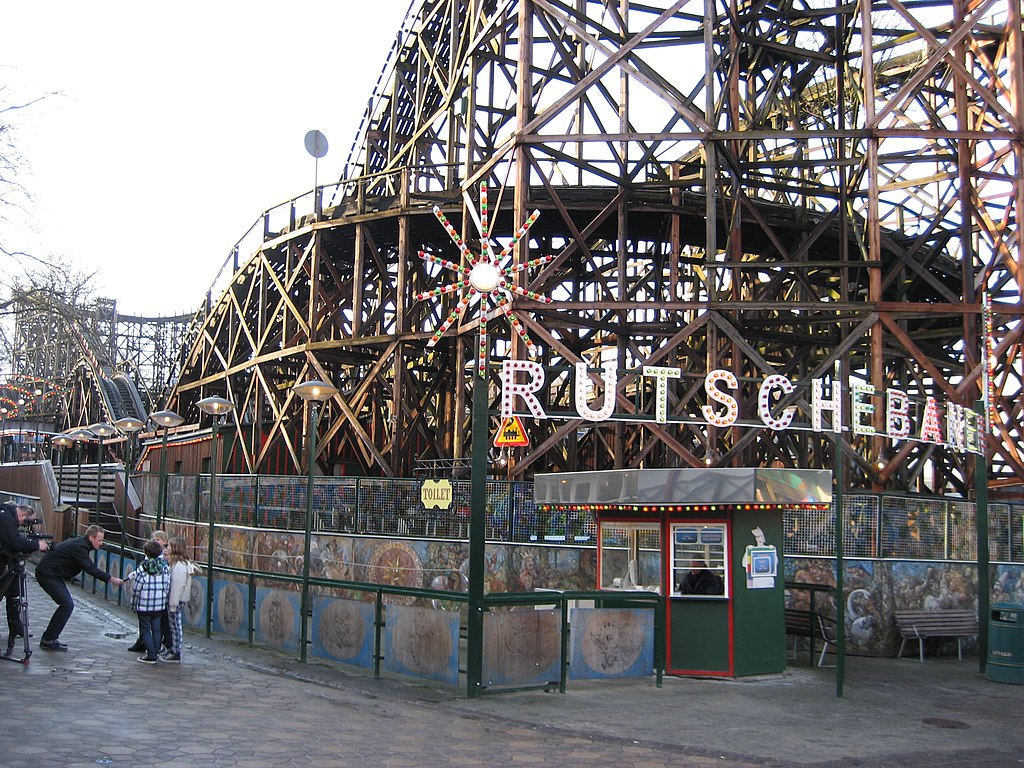Stadiums are more than just venues; they are symbols of national pride and passion for sports. Around the world, some of the largest stadiums are marvels of architecture, hosting tens of thousands of fans for major events. These massive structures not only showcase the love of sport but also serve as cultural landmarks in their respective countries. From iconic football arenas to historic Olympic venues, these stadiums stand out for their size, history, and atmosphere. Each one offers a unique experience, drawing visitors from around the globe to witness unforgettable moments. Here’s a look at the 20 largest stadiums in the world, each with its own story to tell.
Rungrado 1st of May Stadium, Pyongyang, North Korea

The Rungrado 1st of May Stadium, located in Pyongyang, is the largest stadium in the world, with a seating capacity of 114,000. Its massive size covers an area of 20.7 hectares (51 acres) and hosts various sporting and non-sporting events. The stadium was built in 1989, primarily for soccer and athletics. Its distinct design, resembling a magnolia blossom, adds to its iconic status. Over the years, it has hosted mass games and grand performances that often involve tens of thousands of participants. Its sheer scale makes it one of North Korea’s most famous landmarks.
Michigan Stadium, Ann Arbor, Michigan, USA
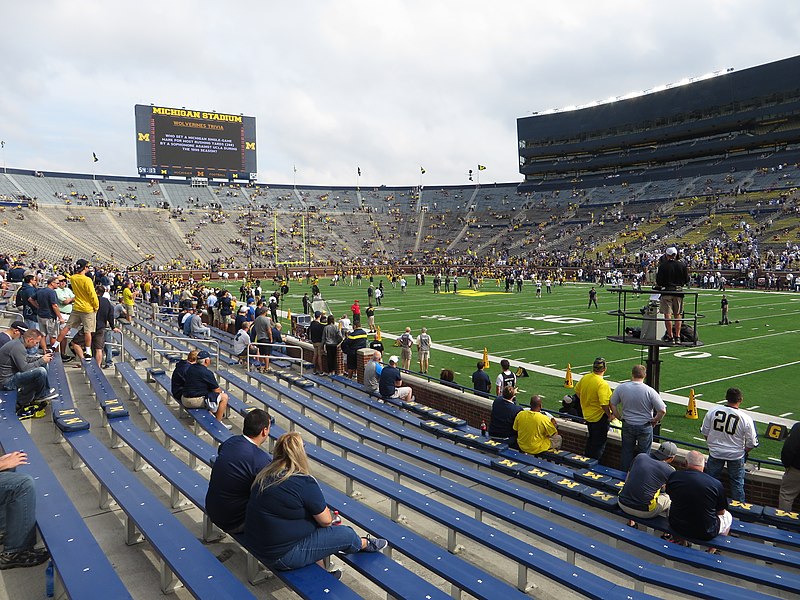
Michigan Stadium, often referred to as “The Big House,” is the second-largest stadium globally, boasting a seating capacity of 107,601. Opened in 1927, this iconic venue is primarily used for college football, home to the Michigan Wolverines. The stadium covers an area of 14.5 acres, with an imposing presence in Ann Arbor. Known for hosting some of the largest crowds in NCAA history, it has exceeded its official capacity on numerous occasions. The stadium’s field is located below ground level, creating a bowl-like structure that amplifies crowd noise. The size and history of Michigan Stadium make it a must-visit for any sports fan.
Beaver Stadium, University Park, Pennsylvania, USA

With a capacity of 106,572, Beaver Stadium stands as one of the largest sports venues in the world. Situated on the campus of Pennsylvania State University, it is primarily used for American football and is home to the Penn State Nittany Lions. The stadium opened in 1960, and its layout has undergone numerous expansions to accommodate its ever-growing fanbase. Covering over 12 acres, its size creates an electrifying atmosphere, especially during night games. Beaver Stadium is renowned for its “White Out” games, where the entire crowd wears white to create a visually striking environment. Its colossal size and passionate fanbase make it a formidable venue for opponents.
Ohio Stadium, Columbus, Ohio, USA
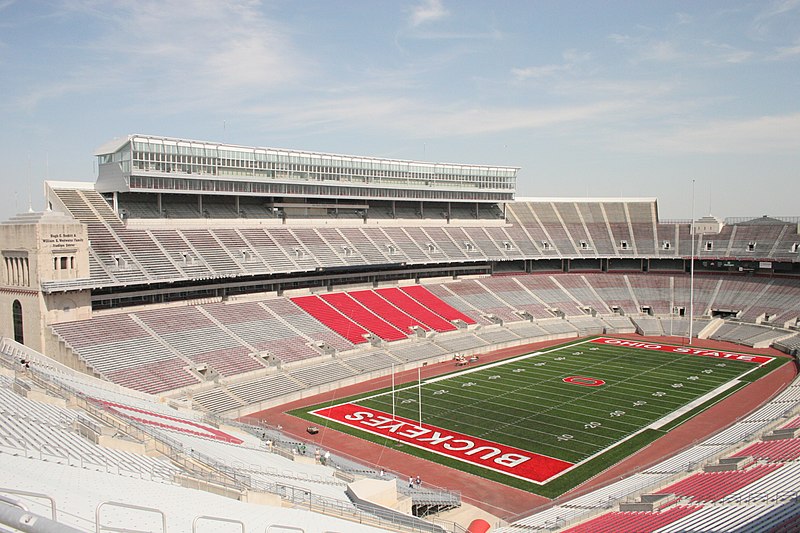
Ohio Stadium, also known as “The Horseshoe,” has a seating capacity of 102,780, making it one of the largest stadiums in the world. Built in 1922, this stadium is the home of the Ohio State Buckeyes football team. The structure spans 11 acres and has a unique horseshoe shape, offering fans excellent sightlines from nearly every seat. The stadium has a rich history, having hosted everything from concerts to military training exercises during World War II. Its modern upgrades, including high-definition video boards, ensure that it stays competitive with newer venues. Ohio Stadium remains an iconic part of American college football culture.
Kyle Field, College Station, Texas, USA

Kyle Field, located at Texas A&M University, holds a capacity of 102,733, making it one of the largest football stadiums in the world. This stadium, built in 1927, is the home of the Texas A&M Aggies and is often regarded as one of the most intimidating places for opposing teams. Covering 13 acres, it is known for its incredibly passionate fanbase, also known as the “12th Man.” The stadium’s modern renovations have enhanced its amenities while preserving its storied tradition. Kyle Field’s massive video board, one of the largest in college football, ensures that fans don’t miss any of the action. The combination of size and fan intensity creates an unforgettable game-day experience.
Tiger Stadium, Baton Rouge, Louisiana, USA

Tiger Stadium, with a seating capacity of 102,321, is one of the largest and most famous college football venues in the United States. Located on the campus of Louisiana State University (LSU), it is affectionately known as “Death Valley” for its intimidating atmosphere. The stadium opened in 1924 and covers 12.5 acres of land. Known for its deafening noise levels, especially during night games, it has become a fortress for LSU Tigers football. Over the years, the stadium has seen numerous expansions and renovations, adding modern amenities while preserving its historic charm. The size and intensity of Tiger Stadium make it a legendary venue in college sports.
Darrell K Royal–Texas Memorial Stadium, Austin, Texas, USA

Darrell K Royal–Texas Memorial Stadium, home to the University of Texas Longhorns, has a seating capacity of 100,119. Opened in 1924, this stadium has a rich history and is one of the largest football venues in the world. It spans over 13 acres and features a distinctive double-deck design that creates a loud and engaging atmosphere. The stadium has seen multiple renovations, including the addition of a giant video board and luxury seating areas. Its iconic location in the heart of Austin makes it a central part of the city’s sports culture. With over a century of tradition, it remains one of the premier venues in American college football.
Melbourne Cricket Ground (MCG), Melbourne, Australia

The Melbourne Cricket Ground, or MCG, is one of the largest stadiums in the world, with a seating capacity of 100,024. Opened in 1853, it is the largest stadium in Australia and is used for various sports, including cricket, Australian Rules Football, and rugby. The MCG covers 20 hectares (about 50 acres) and has hosted many historic events, such as the 1956 Summer Olympics and the 2006 Commonwealth Games. Its sheer size and location in the heart of Melbourne make it a cultural and sporting hub. The stadium’s design and modern amenities ensure that it remains a world-class venue for sports and entertainment. MCG’s place in Australian sports history is unparalleled.
Camp Nou, Barcelona, Spain

Camp Nou, with a capacity of 99,354, is the largest football stadium in Europe and home to FC Barcelona. Opened in 1957, this iconic venue has seen some of the most famous matches in football history. It covers 55,000 square meters (13.6 acres), offering fans a spectacular view from every seat. The stadium has undergone several renovations, including a plan to expand its capacity even further in the coming years. Camp Nou’s location in Barcelona and its ties to one of the world’s most successful football clubs make it a must-see for sports enthusiasts. The atmosphere during matches is electric, creating an unforgettable experience for fans and players alike.
Estadio Azteca, Mexico City, Mexico

Estadio Azteca, located in Mexico City, boasts a seating capacity of 87,523, making it the largest stadium in Mexico. Opened in 1966, it has hosted two FIFA World Cup finals, a distinction only it holds. The stadium spans 27 acres and is known for its high altitude, making it a challenging venue for visiting teams. Estadio Azteca is home to the Mexican national football team and Club América, and it remains one of the most important football venues in the world. In addition to football, it has also hosted concerts, boxing matches, and other significant events. Its legacy in the world of sports is cemented by its size, history, and passionate fanbase.
Bryant-Denny Stadium, Tuscaloosa, Alabama, USA

Bryant-Denny Stadium, home to the University of Alabama football team, holds 100,077 spectators, making it one of the largest stadiums in the world. Opened in 1929, it is named after legendary coach Paul “Bear” Bryant and former university president George H. Denny. Spanning over 12 acres, the stadium’s design creates an intense atmosphere, especially during Alabama Crimson Tide games. The venue has undergone numerous renovations, including the addition of luxury suites and a massive video board. Bryant-Denny is a fortress for Alabama football, where passionate fans create a sea of crimson on game days. The size, history, and energy of the stadium make it a central part of college football culture.
Neyland Stadium, Knoxville, Tennessee, USA

Neyland Stadium, located on the campus of the University of Tennessee, can seat 101,915 fans, ranking among the largest stadiums globally. Built in 1921, it serves as the home for the Tennessee Volunteers football team. Covering 14 acres, Neyland Stadium has seen numerous expansions and renovations, including improved seating and facilities. The stadium is known for its picturesque location along the Tennessee River, adding to the overall game-day experience. Neyland Stadium is revered for its traditions, such as the “Vol Walk,” where fans cheer on players before games. Its size and the passionate fanbase make Neyland a must-visit venue for college football.
Cotton Bowl, Dallas, Texas, USA

The Cotton Bowl Stadium, with a seating capacity of 92,100, is one of the most historic stadiums in the United States. Opened in 1930, it has been the site of countless football games, including the Cotton Bowl Classic and the Red River Showdown between Texas and Oklahoma. Spanning 13 acres, the stadium’s iconic location in Dallas makes it a central part of Texas sports history. Over the years, it has also hosted concerts, soccer matches, and other major events. Its recent renovations have added modern amenities while preserving its historic charm. The Cotton Bowl’s size and history make it a landmark venue for American sports.
Sanford Stadium, Athens, Georgia, USA

Sanford Stadium, located at the University of Georgia, boasts a seating capacity of 92,746, making it one of the largest stadiums in the world. Opened in 1929, it serves as the home for the Georgia Bulldogs football team. Covering nearly 10 acres, Sanford Stadium is known for its picturesque setting, with the Georgia campus and its signature hedges surrounding the field. The venue has undergone numerous expansions to accommodate the growing fanbase, and its game-day atmosphere is renowned in college football. The stadium’s design allows fans to be close to the action, creating an electric environment during games. Its combination of size and tradition makes it one of the premier venues in college sports.
Rose Bowl, Pasadena, California, USA
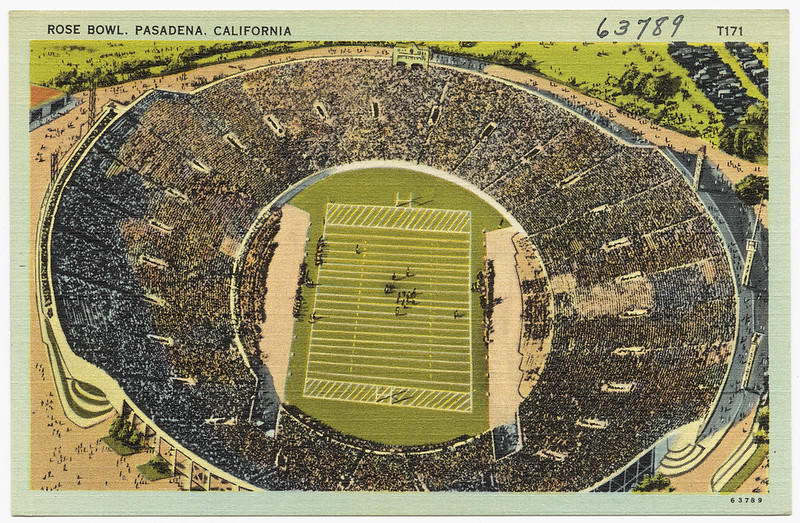
The Rose Bowl, located in Pasadena, California, can seat 88,565 fans, making it one of the largest and most iconic stadiums in the world. Opened in 1922, it is best known for hosting the annual Rose Bowl Game, one of the oldest college football bowl games. The stadium spans 11 acres and is nestled in the picturesque Arroyo Seco, offering stunning views of the surrounding area. In addition to football, the Rose Bowl has hosted several World Cup matches, Olympic events, and concerts. Its history and significance in American sports, combined with its size, make it one of the most famous stadiums globally. The Rose Bowl’s atmosphere and setting offer a unique and unforgettable experience for all who attend.
FNB Stadium, Johannesburg, South Africa
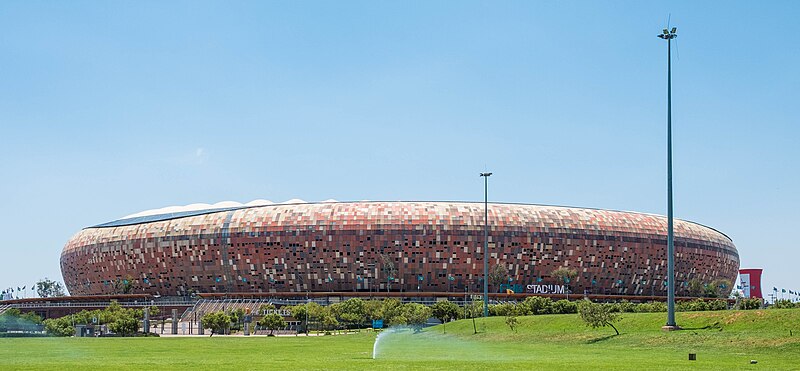
FNB Stadium, also known as Soccer City, is the largest stadium in Africa, with a seating capacity of 94,736. Located in Johannesburg, it was originally built in 1989 and underwent extensive renovations for the 2010 FIFA World Cup. The stadium covers over 40 hectares (98 acres) and is designed to resemble an African calabash, giving it a unique and striking appearance. FNB Stadium is home to the South African national football team and hosts major sporting and cultural events. It was the venue for Nelson Mandela’s first speech after his release from prison in 1990, adding to its historical significance. The combination of size, history, and design makes FNB Stadium one of the premier sports venues in the world.
Wembley Stadium, London, England

Wembley Stadium, located in London, is one of the largest and most famous stadiums globally, with a seating capacity of 90,000. Opened in 2007, it replaced the original Wembley Stadium, which was built in 1923 and hosted many historic events. The new stadium spans 7.4 hectares (18 acres) and is known for its iconic 133-meter-high arch, which is visible throughout much of London. Wembley hosts a variety of events, including football matches, concerts, and the NFL International Series. It has become the home of English football, hosting the FA Cup Final and England national team matches. The stadium’s size, design, and history make it a world-class venue for both sports and entertainment.
Gelora Bung Karno Stadium, Jakarta, Indonesia

Gelora Bung Karno Stadium, located in Jakarta, has a seating capacity of 88,306, making it one of the largest stadiums in Southeast Asia. Built in 1962, the stadium was originally constructed for the Asian Games and has since hosted various sports and cultural events. The venue covers 26 hectares (64 acres), with modern facilities and a striking circular design. Gelora Bung Karno Stadium is home to the Indonesian national football team and has seen numerous upgrades over the years. Its size and versatility make it a central part of Indonesia’s sports landscape. The stadium’s capacity and historical significance make it a major venue for international events.
Ben Hill Griffin Stadium, Gainesville, Florida, USA

Ben Hill Griffin Stadium, also known as “The Swamp,” has a seating capacity of 88,548, making it one of the largest college football stadiums in the United States. Located at the University of Florida, it is home to the Florida Gators football team. The stadium, opened in 1930, covers 11 acres and is known for its intense atmosphere, especially during SEC football games. The Swamp’s design places fans close to the field, amplifying crowd noise and creating a hostile environment for opposing teams. Over the years, the stadium has undergone several expansions to accommodate its growing fanbase. Its combination of size, history, and atmosphere makes Ben Hill Griffin Stadium a standout venue in college sports.
Maracanã Stadium, Rio de Janeiro, Brazil

Maracanã Stadium, located in Rio de Janeiro, has a seating capacity of 78,838, making it one of the largest stadiums in South America. Originally built for the 1950 FIFA World Cup, the stadium has become an iconic symbol of Brazilian football. Covering 11.5 hectares (28.4 acres), Maracanã has hosted some of the most significant events in sports, including the 2014 FIFA World Cup Final and the 2016 Summer Olympics. The stadium’s distinctive circular design allows for excellent sightlines from every seat. Maracanã is home to both the Brazilian national football team and several Rio-based clubs. Its history, size, and location make it one of the most famous stadiums in the world.
This article originally appeared on Rarest.org.
More From Rarest.Org
McDonald’s restaurants are known for their global reach, but some locations stand out not just for their food, but for their sheer size. Around the world, these massive branches offer unique dining experiences, from high-tech features to entertainment options. Read more.
Wooden roller coasters have been thrilling riders for over a century, with some of the oldest still in operation today. These coasters, built long before the modern steel giants, hold a special place in amusement park history. Read more.
Insects come in all shapes and sizes, but some truly stand out for their massive proportions. From towering beetles to enormous butterflies, these insects are not only impressive in size but also play important roles in their ecosystems. Read more.


